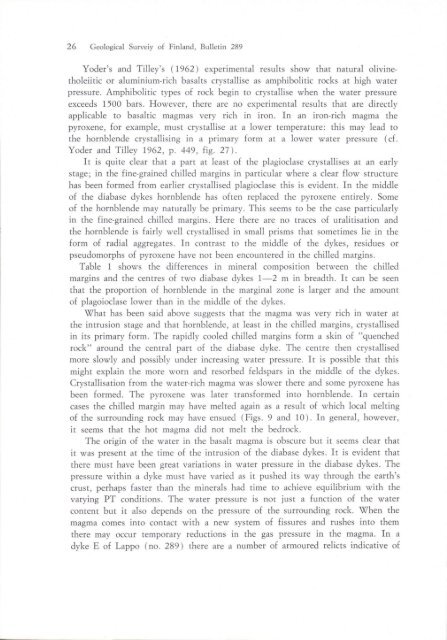Geological Survey of Finland Bulletin 289 - arkisto.gsf.fi
Geological Survey of Finland Bulletin 289 - arkisto.gsf.fi
Geological Survey of Finland Bulletin 289 - arkisto.gsf.fi
You also want an ePaper? Increase the reach of your titles
YUMPU automatically turns print PDFs into web optimized ePapers that Google loves.
26 <strong>Geological</strong> Surveiy <strong>of</strong> <strong>Finland</strong>, <strong>Bulletin</strong> <strong>289</strong><br />
Yoder's and Tilley's (1962) experimental results show that natural olivinetholeiitic<br />
or aluminium-rich basalts crystallise as amphibolitic rocks at high water<br />
pressure. Amphibolitic types <strong>of</strong> rock begin to crystallise when the water pressure<br />
exceeds 1500 bars. However, there are no experimental results that are direct1y<br />
applicable to basaltic magmas very rich in iron. In an iron-rich magma the<br />
pyroxene, for example, must erystallise at a lower temperature: this may lead to<br />
the hornblende erystallising in a primary form at a lower water pressure (cf.<br />
Yoder and Tilley 1962, p. 449, Hg. 27 ).<br />
It is quite dear that apart at least <strong>of</strong> the plagiodase crystallises at an early<br />
stage; in the <strong>fi</strong>ne-grained chilIed margins in particular where a dear flow structure<br />
has been formed from earlier crystallised plagiodase this is evident. In the middle<br />
<strong>of</strong> the diabase dykes hornblende has <strong>of</strong>ten replaced the pyroxene entirely. Some<br />
<strong>of</strong> the hornblende may naturally be primary. This seems to be the case particularly<br />
in the <strong>fi</strong>ne-grained chilled margins. Here there are no traces <strong>of</strong> uralitisation and<br />
the hornblende is fairly weH crystallised in small prisms that sometimes lie in the<br />
form <strong>of</strong> radial aggregates. In contrast to the middle <strong>of</strong> the dykes, residues or<br />
pseudomorphs <strong>of</strong> pyroxene have not been encountered in the chilled margins.<br />
Table 1 shows the differences in mineral eomposition between the chilled<br />
margins and the centres <strong>of</strong> two diabase dykes 1-2 m in breadth. It can be seen<br />
that the proportion <strong>of</strong> hornblende in the marginal zone is larger and the amount<br />
<strong>of</strong> plagoiodase lower than in the middle <strong>of</strong> the dykes.<br />
What has been said above suggests that thc magma was very rieh in water at<br />
the intrusion stage and that hornblende, at least in the chilled margins, crystallised<br />
in its primary form. The rapidly cooled chilled margins form a skin <strong>of</strong> "quenched<br />
rock" around the central part <strong>of</strong> the diabase dyke. The centre then crystallised<br />
more slowly and possibly under increasing water pre sure. It is possible that this<br />
might explain the more worn and resorbed feldspars in the middle <strong>of</strong> the dykes.<br />
Crystallisation from the water-rieh magma was slower [here and some pyroxene has<br />
been formed. The pyroxene was later transformed into hornblende. In certain<br />
cases the chilled margin may have melted again as a result <strong>of</strong> which local melting<br />
<strong>of</strong> the surrounding rock may have ensued (Figs. 9 and 10 ). In general, however,<br />
it seems that the hot magma did not melt the bedrock.<br />
The origin <strong>of</strong> the water in the basalt magma is obscure but it seems dear that<br />
it was present at the time <strong>of</strong> the intrusion <strong>of</strong> the diaba e dykes. It is evident that<br />
there must have been great variations in water pressure in the diabase dykes. The<br />
pressure within a dyke must have varied as it pushed its way through the earth's<br />
crust, perhaps faster than the minerals had time to achieve equilibrium with the<br />
varying PT conditions. The water pressure is not just a function oE the water<br />
content but it also depends on the pressure <strong>of</strong> the surrounding rock. When the<br />
magma comes into contact with a new system <strong>of</strong> <strong>fi</strong>ssures and rushes into them<br />
there may occur temporary reductions in the gas press ure in the magma. In a<br />
dyke E <strong>of</strong> Lappo (no. <strong>289</strong> ) there are a number <strong>of</strong> armoured relicts indicative <strong>of</strong>

















